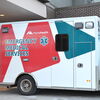Processing Your Payment
Please do not leave this page until complete. This can take a few moments.
The FAA has invested $26M in Maine's airports this year — here's how they use it
At least once a week, doctors fly out of the Augusta State Airport and head north to Aroostook County's Northern Maine Regional Airport in Presque Isle. They spend the day treating patients in Caribou or Presque Isle, providing specialized care that otherwise would have required their patients to drive two-and-a-half hours to Bangor, five hours to Portland or seven hours to Boston.
“We've been doing that for 25 years or more,” says William Perry, president of Maine Instrument Flight, the company founded 70 years ago by his father to provide flight training at the Augusta State Airport. “So we're able to help the people of Aroostook County have access to the doctors they need that otherwise they might not have had.”
The Federal Aviation Administration, through grants funded by the Airport Improvement Program, plays a significant but often overlooked role in supporting those chartered medical flights and all the other essential services provided by Maine's 35 public-use airports.
Year to date, the FAA has awarded $26.43 million to airport infrastructure projects throughout Maine — including $394,694 at the Augusta airport to rehabilitate its apron, runway and taxiway pavement and more than $4.6 million to replace almost 4,000 feet of taxiway at the Presque Isle airport. Those projects, in turn, keep dozens of general contractors, paving companies, electrical engineers and consulting firms busy upgrading Maine's airport infrastructure.
Perry, who earned his commercial pilot's license in 1957, says Maine's 35 public-use airports are an essential lifeline for both urban and rural regions of the state. From medivac flights to corporate travel, commercial passenger service and simple pleasure flying, he says, airports are a key part of the state's transportation system.
The 35 airports have a $2.94 billion economic impact, including a $792 million total payroll, according to a January 2015 report by the FAA. The airports were responsible for transporting 2.27 million passengers and 28,164 tons of freight. They supported 26,657 direct and indirect jobs.
Training the next generation of aviators
Maine Instrument Flight has six charter airplanes that fly passengers to and from airports across the country and the Caribbean. Its turboprop Beechcraft King Air C90A has enough range to fly from Augusta to Orlando, but it's also capable of flying to smaller airports with shorter runways, such as Islesboro, which Perry says is a frequent charter destination in the summer months for seasonal residents that rely on his planes to get them there.
“We do backup work for a charter organization out of Connecticut, picking up passengers in Bar Harbor or Bangor for them,” he adds. “We don't just fly people out of Augusta. We serve a lot of airports in Maine. It's on-demand travel.”
As the fixed-based operator for Augusta State Airport, Perry says Maine Instrument Flight plays an integral role in providing essential services that include fuel sales, flight instruction, aircraft rental and sales, storage for private and corporate aircraft, major airframe maintenance and repair, a pilot rest area, catering and even a conference room for corporate meetings.
Aviation infrastructure, in his view, includes having enough trained people with the skills to fly and maintain the planes supported by Maine's airports. To meet a growing need for trained pilots, Maine Instrument Flight partnered four years ago with the University of Maine in Augusta to offer a bachelor-of-science in aviation degree program.
“The first class is about to graduate next spring,” Perry says. “We know the need for pilots around the country is extreme. We know of commuter airlines that have reduced operations because they don't have enough pilots. So these graduates someday will help meet some of that demand.”
“We're one of the oldest flight schools in the country,” adds Paul McKeown, chief flight instructor at Maine Instrument Flight. “This is the same company, the same family, that's been teaching people to fly for 70 years. That's pretty impressive.”
McKeown says UMA's aviation degree program offers an in-state alternative to Embry-Riddle Aeronautical University's four-year program offered at campuses in Daytona Beach, Fla., and Prescott, Ariz. The UMA graduates will not only have flown 300 hours to earn their FAA commercial pilot's license along with a bachelor's degree, he says, upon graduation they'll have an opportunity to become flight instructors at Maine Instrument Flight and thereby accrue the additional hours of flying time they'll need to work for an airline.
“It can take two years or more to get the 700 hours or more they'll need,” he says. “It's a good plan for someone who's looking at a career as an airline pilot.”
Presque Isle's link to the world
Northern Maine Regional Airport in Presque Isle advertises itself as “Gateway to Northern Maine,” a slogan supported in a big way by Alaska-based commuter airline PenAir's 19 nonstop flights per week between Presque Isle and Boston's Logan Airport. Flight time to and from Boston, covering 332 miles, is 1 hour and 40 minutes.
Scott Wardwell, the airport's director, notes that Northern Maine Regional was one of only a handful of airports in New England that saw an increase in passenger boardings in 2015 — with the FAA reporting a 4.85% increase to 12,928 enplanements. The airport boasts the second longest runway in Maine, measuring 7,440 feet, which is complemented by a second runway of 6,000 feet.
Wardwell says the airport got a boost in early February from the 2016 International Biathlon Union World Cup, which resulted in more than 300 of the world's top biathletes from 32 countries flying into The County to compete in the combined cross-country skiing and rifle-shooting event hosted by the Nordic Heritage Center in Presque Isle.
“The bulk of the athletes and coaches came through Presque Isle,” Wardwell says. “Because we've maintained our facility here at a good size, athletes were able to fly directly here from Calgary, Canada.”
A $4.6 million FAA grant for the taxiway project, he says, enhances the airport's ability to attract larger jets such as those that arrived for the biathlon.
Like Perry in Augusta, Wardwell says training new pilots is as critical to the industry's overall health as paving runways and taxiways.
“If you have no pilots you have no flights,” he says. “We're actively trying to increase our air passenger service. So we're very aware that's not going to be possible if we don't have the pilots to fly here.”
Sanford's 'reliever' airport
Sanford Seacoast Regional Airport, a city-owned airport with slightly more than 100 aircraft based there, is one of two airports in Maine (the other being Auburn/Lewiston Municipal Airport) designated by the FAA as a “reliever” airport.
As such, says airport manager Allison Rogers, Sanford provides an alternative landing site for corporate and other small aircraft traffic that might find it easier to land there than at the region's hub airport, the Portland International Jetport. The Bush family uses the Sanford airport for easy access to the summer compound in Kennebunkport, she says, as do Walmart and Lowe's when officials fly in from their corporate headquarters to visit Maine stores.
Reliever airports account for approximately 10% of airports nationwide receiving funding through the FAA's Airport Improvement Program.
“It doesn't give us more or less funding than we're entitled to receive, but it gives us extra consideration if we're seeking discretionary funds,” she says of Sanford's status as a reliever airport.
Rogers says FAA's AIP is the primary funding source for infrastructure needs at Sanford and the state's other public airports.
“That's a government program that actually works very well,” she says. “The AIP has its own trust fund, which receives 100% of its funding from aviation-generated user fees. A portion of each purchased air ticket goes into this fund. So if you don't fly, you don't pay into this program.”
As a “non-primary general aviation airport,” Sanford Seacoast Regional Airport is able to receive up to $150,000 each year to complete AIP-eligible projects under current FAA and Maine Department of Transportation funding formulas. The annual sum can also be carried forward for up to four years to accumulate funding for more costly projects. AIP funding typically covers up to 90% of eligible costs.
Larger, primary airports — which must have at least 10,000 yearly passengers to qualify — are entitled to at least $1 million annually.
An airport's master plan, outlining its capital improvement and infrastructure needs in five-year increments for up to 20 years, provides the essential documentation needed to qualify for those federal AIP funds. That's why, soon after becoming Sanford's airport manager in June 2013, Rogers made it a top priority to update the airport's 2003 master plan, a project she says was paid for using AIP funds.
Completed in October 2015, the updated master plan already is advancing two of the Sanford airport's top goals: 1), improving its safety and security and, 2), achieving and maintaining financial self-sufficiency.
Rogers says the FAA and MDOT's acceptance of the updated plan's designation of specific areas of the airport's footprint as suitable for “non-aeronautical” uses is what paved the way for the city to approve in mid-October a long-term lease with Ranger Solar of Yarmouth for a utility-scale, 50-megawatt solar project that would be built on 390 acres of city-owned at the airport. When completed it would be one of the largest in Maine, providing enough electricity to power up to 20,000 homes, adding up to $80 million in new taxable property and creating approximately 94 construction jobs and up to 10 full-time positions.
“They've agreed to fence the airport for us, which at $150,000 a year [in AIP funding] would take 10 years,” Rogers says. “The fence will keep wildlife out and improve the safety of the airport.”
The lease payments, she adds, are expected to more than cover the airport's $200,000-plus annual operating expenses. “This will make us financially self-supporting,” she says, figuratively checking off the second of the airport's top goals.
A pilot since high school and a 2008 graduate of the Florida Institute of Technology's bachelor's degree program in aviation management, Rogers credits her five years working at the Hancock County-Bar Harbor Airport with honing her strategic planning skills for identifying capital projects and business initiatives that help sustain an airport over the long term.
Although the Sanford airport only has a little more than 100 aircraft based there, as a former Navy air base it's blessed with ample room for future growth. It has two runways — 6,389 feet and 5,000 feet respectively — which can accommodate the largest of corporate jets. Its geographic footprint covers 1,100 acres. Portland International Jetport, by comparison, encompasses 725 acres and has runways that are 7,200 feet and 6,100 feet long.
“We could easily add 100 more hangars here if we had to,” she says, adding that keeping the Sanford airport's infrastructure in top shape is the key to its future growth and success.
Read more
C&L Aerospace eyes expansion at Bangor airport
Portland Jetport named best airport in North America
‘Build your own’ hangar lots available at Brunswick Executive Airport
Feds award $4M for Maine airport expansion projects
Over $1M in federal funds awarded to Greenville airport
Airplane hangars can be energy-efficient too — for $1.5M
Elite Airways' expanded Florida service offers winter respite
Ranger Solar advances its 50MW solar project at Sanford airport












Comments